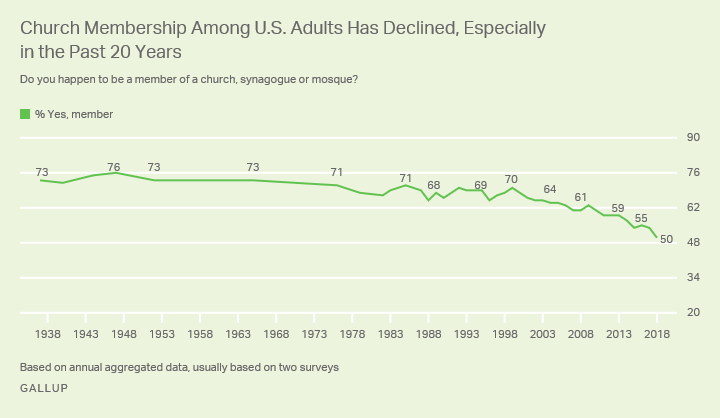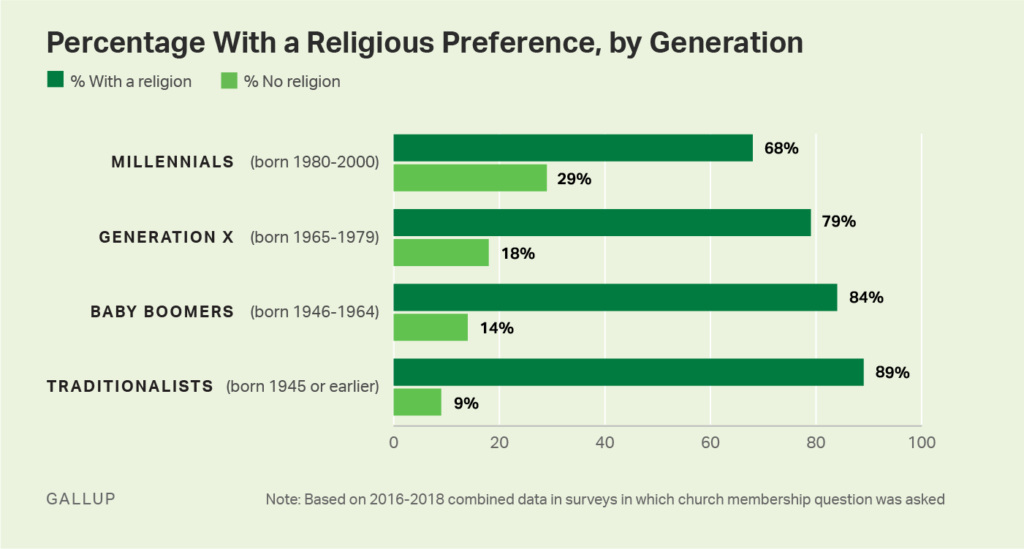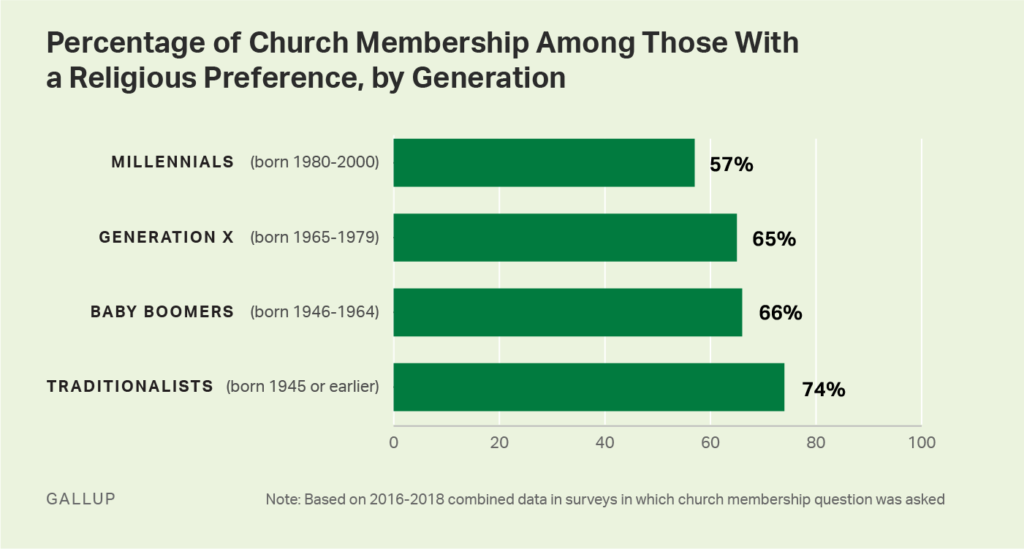U.S. church membership down sharply in past two decades – Percentage of Americans who report belonging to a church, synagogue, or mosque at all-time low, averaging 50 percent in 2018

By Jeffrey M. Jones
18 April 2019
WASHINGTON, D.C. (Gallup) – As Christian and Jewish Americans prepare to celebrate Easter and Passover, respectively, Gallup finds the percentage of Americans who report belonging to a church, synagogue or mosque at an all-time low, averaging 50% in 2018.
U.S. church membership was 70% or higher from 1937 through 1976, falling modestly to an average of 68% in the 1970s through the 1990s. The past 20 years have seen an acceleration in the drop-off, with a 20-percentage-point decline since 1999 and more than half of that change occurring since the start of the current decade.
The decline in church membership is consistent with larger societal trends in declining church attendance and an increasing proportion of Americans with no religious preference.
This article compares church membership data for the 1998-2000 and 2016-2018 periods, using combined data from multiple years to facilitate subgroup analysis. On average, 69% of U.S. adults were members of a church in 1998-2000, compared with 52% in 2016-2018.
The decline in church membership mostly reflects the fact that fewer Americans than in the past now have any religious affiliation. However, even those who do identify with a particular religion are less likely to belong to a church or other place of worship than in the past.
Trend Toward No Religious Preference Key Factor in Declining Membership
Since the turn of the century, the percentage of U.S. adults with no religious affiliation has more than doubled, from 8% to 19%.
Although some of those who do not identify with a religion nevertheless indicate that they belong to a church, the vast majority of nonreligious Americans do not. In 1998 through 2000, one in 10 Americans with no religious preference said they belonged to a church, as did an average of 7% in the past three years.
As such, there is an almost one-to-one correspondence between not being religious and not belonging to a church. Consequently, the 11-point increase in no religious affiliation accounts for the majority of the 17-point decline in church membership over the past two decades.
Fewer Religious Americans Are Church Members
Although there has been a steep increase in the proportion of Americans who do not have a religious attachment, they remain a small minority of the U.S. population. Three-quarters of Americans, 77%, identify with some organized religion, though that is down from 90% in 1998 through 2000.
The still-sizable proportion of religious Americans also contribute to declining church membership, as fewer in this group belong to a church than did so two decades ago. At the turn of the century, 73% of U.S. adults with a religious preference belonged to a church, compared with 64% today.
It is clear then, that the nature of Americans’ orientation to religion is changing, with fewer religious Americans finding membership in a church or other faith institution to be a necessary part of their religious experience.

Generational Change Helping Push the Decline in Church Membership
Religiosity is strongly related to age, with older Americans far more likely than younger adults to be members of churches. However, church membership has dropped among all generational groups over the past two decades, with declines of roughly 10 percentage points among traditionalists, baby boomers and Generation X.
Most millennials were too young to be polled in 1998-2000. Now that they have reached adulthood, their church membership rates are exceedingly low and appear to be a major factor in the drop in overall U.S. church membership. Just 42% of millennials are members of churches, on average.
By comparison, 20 years ago, 62% of members of Generation X belonged to a church, when they were about the same age as millennials are today.
The low rates of church membership among millennials conform with the generation’s weaker attachment to religion in general. On average, 68% of millennials identify with a religion in the 2016-2018 church membership surveys, while 29% do not. In all other generations, at least 79% have a religious affiliation, with correspondingly lower percentages expressing no faith preference.

The percentage of millennials with no religion may be continuing to grow, as an average of 33% in Gallup surveys conducted in 2019 to date say they have no religious affiliation.
Not only are millennials less likely than older Americans to identify with a religion, but millennials who are religious are significantly less likely to belong to a church. Fifty-seven percent of religious millennials belong to a church, compared with 65% or more in older generations. […]
Membership Decline Steeper Among Catholics
Gallup has previously reported that church attendance has dropped more among Catholics than among Protestants. Consistent with this, the decline in church membership has been greater among Catholics. Twenty years ago, 76% of Catholics belonged to a church; now, 63% do.
Meanwhile, 67% of Protestants, down from 73% in 1998-2000, are members of a church. Much of the decline in Protestant membership is attributable to the increasing percentage of Americans who simply identify their religion as “Christian” rather than as a specific Protestant denomination such as Baptist, Lutheran or Methodist. Gallup classifies “Christian” respondents as Protestants but, as might be expected, nondenominational Christians are less likely to belong to a church (57%) than Americans who identify with a specific Protestant denomination (70%). [more]